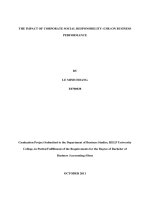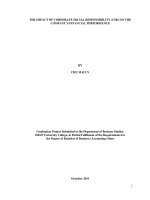The Impact of Equipment Availability and Reliability on Mission Outcomes - An Initial Look pdf
Bạn đang xem bản rút gọn của tài liệu. Xem và tải ngay bản đầy đủ của tài liệu tại đây (1.28 MB, 65 trang )
CHILDREN AND ADOLESCENTS
CIVIL JUSTICE
This PDF document was made available from www.rand.org as a public
service of the RAND Corporation.
EDUCATION
ENERGY AND ENVIRONMENT
HEALTH AND HEALTH CARE
Jump down to document6
INTERNATIONAL AFFAIRS
POPULATION AND AGING
PUBLIC SAFETY
SCIENCE AND TECHNOLOGY
SUBSTANCE ABUSE
TERRORISM AND
HOMELAND SECURITY
The RAND Corporation is a nonprofit research
organization providing objective analysis and effective
solutions that address the challenges facing the public
and private sectors around the world.
TRANSPORTATION AND
INFRASTRUCTURE
U.S. NATIONAL SECURITY
Support RAND
Purchase this document
Browse Books & Publications
Make a charitable contribution
For More Information
Visit RAND at www.rand.org
Explore RAND Arroyo Center
View document details
Limited Electronic Distribution Rights
This document and trademark(s) contained herein are protected by law as indicated in a notice
appearing later in this work. This electronic representation of RAND intellectual property is provided
for non-commercial use only. Permission is required from RAND to reproduce, or reuse in another
form, any of our research documents for commercial use.
This product is part of the RAND Corporation documented briefing series. RAND
documented briefings are based on research briefed to a client, sponsor, or targeted audience and provide additional information on a specific topic. Although documented
briefings have been peer reviewed, they are not expected to be comprehensive and may
present preliminary findings.
The Impact of Equipment
Availability and Reliability
on Mission Outcomes
An Initial Look
CHARLES T. KELLEY
DB-423-A
February 2004
Prepared for the United States Army
Approved for public release; distribution unlimited
The research described in this report was sponsored by the United States Army under
Contract No. DASW01-01-C-0003.
ISBN: 0-8330-3472-3
The RAND Corporation is a nonprofit research organization providing objective analysis
and effective solutions that address the challenges facing the public and private sectors
around the world. RAND’s publications do not necessarily reflect the opinions of its research
clients and sponsors.
Rđ is a registered trademark.
â Copyright 2004 RAND Corporation
All rights reserved. No part of this book may be reproduced in any form by any electronic or
mechanical means (including photocopying, recording, or information storage and retrieval)
without permission in writing from RAND.
Published 2004 by the RAND Corporation
1700 Main Street, P.O. Box 2138, Santa Monica, CA 90407-2138
1200 South Hayes Street, Arlington, VA 22202-5050
201 North Craig Street, Suite 202, Pittsburgh, PA 15213-1516
RAND URL: />To order RAND documents or to obtain additional information, contact
Distribution Services: Telephone: (310) 451-7002;
Fax: (310) 451-6915; Email:
PREFACE
This documented briefing describes an initial effort to understand
analytically how start-of-mission availability and during-mission
reliability of Army equipment affect ground combat capability and to
assess consequent implications for current and future forces. Combat
results were simulated using the JANUS model and scenarios available
from prior research. The principal scenario for the analysis was a forced
entry by U.S. forces into rough and heavily foliaged terrain to neutralize
Red forces and stop ethnic cleansing. A second scenario considered an
offensive mission in more open terrain. The briefing then draws upon
broader reasoning and approximate analysis to suggest tentative
conclusions, and it recommends features of more detailed work.
This research should interest those charged with logistics support of the
Army’s legacy forces, those engaged in ensuring that legacy forces remain
capable until they are phased out, and those involved in developing the
Army’s Objective Force, including its organizational structure and
equipment requirements.
This research was sponsored by the Assistant Secretary of the Army for
Acquisition, Logistics, and Technology and was conducted in the Military
Logistics Program of the RAND Arroyo Center. The Arroyo Center is a
federally funded research and development center sponsored by the
United States Army.
iii
For more information on RAND Arroyo Center, contact the Director of
Operations (telephone 310-393-0411, extension 6419; FAX 310-451-6952;
e-mail ), or visit the Arroyo Center’s Web site at
/>
iv
SUMMARY
Two important measures of Army readiness are the availability of
equipment for use at the beginning of a combat mission (“start-of-mission
capability”) and the reliability of that equipment over the course of the
mission (“during-mission reliability”). While the usefulness of these
measures is widely recognized, few attempts have been made to quantify
their impact on combat capability.
A better understanding of the relationship of equipment availability and
reliability to combat capability can help the Army address both current
and future force needs. Army planners need to understand how current
equipment availability and reliability rates are affecting combat
capabilities, and how those capabilities might be impacted due to
equipment age and/or rebuilding. Those involved in the design and
development of future forces need to understand how to achieve the
greatest leverage in these systems, e.g., whether through significant
improvements in equipment reliability or investments in other systemenhancing characteristics, such as robotics.
In this documented briefing we describe an initial effort to quantify the
effects of start-of-mission availability and during-mission reliability of
Army ground equipment on combat capability. This “first look” analysis
used JANUS, a force-on-force simulation model, to examine four issues
relevant to current and future forces.
For the current force:
• How do changes in equipment availability and/or reliability affect
combat results?
• How does equipment degradation due to age affect combat capability?
• To what degree could the combat capability of current systems be
enhanced through rebuilding to mitigate the effects of aging?
For the Objective Force:
v
• How might a very significant improvement in equipment
supportability affect combat capability relative to other systemenhancing characteristics, such as robotics?
Our main scenario for analysis involved a small-scale contingency (SSC)
with a U.S. brigade-sized force on the offense against a comparably-sized,
but less effective, adversary. The principal scenario takes place on heavily
wooded terrain (based on digital terrain data from Kosovo). For purposes
of comparison, we also considered a second scenario in more open terrain.
For the current force, the U.S. unit is a heavy brigade with more than 400
pieces of heavy equipment, including three predominant systems—
referred to here as the “Big 3”—54 M1A1s, 159 M2A2s, and 45 M2A3s. In
JANUS, these U.S. systems achieved nearly 90 percent of the kills and
suffered about 70 percent of the casualties. For the Objective Force, the
U.S. unit is a brigade combat team (BCT) or Unit of Action (UA).
We used data collected at the National Training Center (NTC) in order to
explicitly model equipment availability and/or reliability at the start of
the operation; after a road march of 0, 50, or 100 kilometers; and at the
time of shots during the engagement.
Initial Equipment Availability Has a Moderate Effect on
Combat Outcomes
To understand the sensitivity of combat results to different levels of
equipment availability, we arbitrarily decreased the availability of “Big 3”
systems from 100 to 40 percent in steps of ten percentage points. Our
analysis found that varying the level of initial equipment availability had
a moderate effect on combat outcomes. We measured this effect using the
loss exchange ratio, which refers to the total number of enemy losses
divided by the total number of U.S. losses.
We found that as the availability of equipment decreases, the loss
exchange ratio decreases moderately. A second scenario in more open
terrain yielded similar results. But while we found that equipment
availability has a moderate effect on combat outcomes, we did not see a
catastrophic fall-off in capability. In other words, the simulation showed
no clear threshold beyond which a force would not be mission-capable.
The lack of such a fall-off in the simulation could be at least partially the
vi
result of the model construct, however, since it does not account for
human behavior or organizational network effects.
Some Initial Availability and Engagement Failures Have a
Significant Adverse Impact
While equipment availability had a relatively modest effect on the loss
exchange ratio, availability and reliability failures were found to have
significant adverse impacts on other measures of effectiveness,
particularly the number of vehicles available for a second engagement.
Figure S.1 shows the loss exchange ratio, the number of enemy units
killed, and the number of U.S. Big 3 vehicles available at the end of the
combat engagement over a base case and three alternative scenarios. The
base case uses 100 percent initial equipment availability and reliability,
while all of the alternatives use current equipment availability and
reliability data derived from NTC experience, and each progressively
Initial Availability and Engagement Failures Have a
Significant Adverse Impact on Some Combat
MOEs
Serb
units
killed
80
60
U.S. forces
for
subsequent
control
Exchange
240
Ratio =
1.15
1.06
180
0.96
0.9
40
20
0
120
60
0
Base
Case
0 km
50 km
100 km
Current availability
and reliability
Figure S.1—Impact of Availability and Reliability Failures on Combat
Measures of Effectiveness (MOEs)
vii
illustrates the effects of distance traveled (0, 50, or 100 km) before the
engagement commences. The loss exchange ratio is indicated by the
number on top of each bar, while the upper dashed line indicates the
number of enemy platforms killed and the lower dashed line indicates the
size of the U.S. force immediately at the end of the engagement, as
measured by the number of active Big 3 vehicles.
As indicated by the figure, shifting from the base case to cases using an
estimate of current equipment supportability shows a significant
degradation in the combat performance of the U.S. heavy brigade. This
degradation becomes more pronounced the farther the distance traveled.
For example, for the 100-km road march, the size of the U.S. force at the
end of combat drops to about 100 from about 200 Big 3 vehicles in the base
case. Such a significant drop-off in availability could create a high level of
risk, potentially leaving the force with low readiness for an immediate
second engagement.
Capability Degrades Further With Equipment Age
Combat capability was found to degrade further as reliability decreases
with equipment age. In the simulation, we assumed that from 2000 to
2015, availability would remain at current rates while reliability would
decrease by about 4 percent a year, which is approximately the rate at
which M1 reliability has been shown to decrease during the first 14 years
of its operation.
The resulting analysis showed that combat capability of the force
degrades as the force ages. In the worst case, the loss exchange ratio fell
from 1.15 in the base case to 0.87, while the number of enemy elements
killed dropped from 70 to 45, and the size of the Big 3 occupying force fell
to 75 vehicles, only about a third as large as the 205 remaining in the base
case.
Rebuilding Equipment Can Substantially Increase
Equipment Availability and Reliability
Further analysis showed that rebuilding equipment can substantially
increase availability. Our analysis showed that rebuilding equipment can
more than maintain current combat capability. We modeled the results of
2015 reliability after a rebuild of Big 3 equipment to M1A2 availability
viii
and reliability levels. The analysis found that the capability of the rebuilt
equipment in 2015 more than matches the capability of current equipment
in 2000, if the enemy does not also make comparable improvements.
Technologies May Have Greater Benefit to Future Systems
Than Improvements in Reliability, If Costs Are Not an Issue
To evaluate BCT issues for the Objective Force, we used a series of
alternative BCT configurations developed as part of an earlier RAND
Arroyo Center study for the Army Science Board (ASB). Our analysis
used the same Kosovo scenario but replaced the M1, M2, and HMMWV
with the Future Combat System (FCS) and included an upgraded enemy
threat. We examined the performance of five BCT configurations as
defined in the ASB study. These ranged from a “vanilla” configuration,
with standard versions of the 20-ton Light Armored Vehicle (LAV) with
Level III protection, to alternative configurations, each of which adds
increasingly sophisticated technologies, such as robotic vehicles for
reconnaissance; notional miniature line-of-sight anti-tank (LOSAT)
missiles and a machine gun; “Quickdraw” to detect muzzle flash and
immediately return fire; and an active protection system (APS) for combat
vehicles.
The analysis indicated that the combat capability enhancements produce
much greater leverage than do improvements to supportability alone.
Figure S.2 illustrates the results.
The capabilities possible through improved availability and reliability are
indicated by the lower and higher dots to the left of the diagram. The
lower dot indicates the loss exchange ratio for a vanilla BCT with FCSs
that have the same availability and reliability as today’s M1A1, while the
higher dot indicates the loss exchange ratio for a vanilla BCT with FCSs
that are significantly more reliable than today’s M1A1s.
While higher availability and reliability led to an improved loss exchange
rate in the simulation, much greater gains were found to be possible
through the addition of technology, as indicated by the step-like lines
extending across the figure. The dashed line represents the kills of
manned and robotic vehicles, while the solid line represents the kills of
manned vehicles only.
ix
In One Engagement, Some Combat Capability
Enhancements Produce Much Greater Leverage
Than Supportability Improvement
3
50 km
road march
Loss
exchange
ratio
(Serb losses/
U.S. losses)
Kills of only
manned vehicles
2
Vanilla BCT with
more reliable FCS
Include
killed
robots
1
BCT with FCS that
has M1A1 reliability
0
“Vanilla”
Substitute
robotic
recce
vehicles
Arm
robots
Add
Add APS
Quickdraw
to all
to robots
combat
vehicles
BCT Configuration
Figure S.2—Effect of Reliability and Technological Advances on
Combat Capability
By including all improvements to the vanilla BCT, the loss exchange ratio
increases to about 2.0 (2.4 for manned vehicles only) compared to a loss
exchange ratio of about 1.0 for the vanilla BCT with M1A1-like
supportability. When only manned vehicles are considered, except for the
addition of Quickdraw, the technologies improve the loss exchange rate
by a greater amount than the improvement to reliability alone. When
both manned and unmanned vehicles are considered, there is a decrease
in loss exchange ratio when only robots are added to the force, indicating
that they are being killed at a faster rate than were the manned vehicles
they replaced.
Although these results suggest that performance-enhancing
improvements are more valuable than this level of supportability
improvements for one engagement, it must be remembered that no
account was taken of the costs of achieving either improved supportability
or the technological advances in performance. Nor did the analysis
x
evaluate the likelihood of achieving improved supportability or the
technological advances that were modeled.
CONCLUSIONS
We found that JANUS was a useful tool for analyzing some of the
implications of equipment availability and reliability on ground combat
outcomes. However, future analyses should explore additional
approaches, including the potential for a catastrophic fall-off in combat
effectiveness due to equipment unavailability, the effects of availability
and reliability over a series of engagements, and the cost-effectiveness of
reliability and other system-enhancing improvements.
xi
ACKNOWLEDGMENTS
The author is grateful to his RAND colleagues for their considerable
assistance on this study. Eric Peltz suggested this research and provided
many helpful suggestions throughout the course of the study, including
many valuable comments on this report. Thomas Herbert and Phyllis
Kantar helped the author become familiar with the JANUS scenarios and
their use in prior RAND research. Special thanks are due to Angela Stich,
who made all of the JANUS model runs and compiled the engagement
results. Additionally, she made the programming modifications to
JANUS that were necessary for the conduct of this research. The author is
especially grateful to Paul Davis and David Diener for their many helpful
comments on an earlier draft.
xiii
The Impacts of Equipment Availability and
Reliability on Mission Outcomes:
An Initial Look
This documented briefing describes an initial effort to quantify the
effects of start-of-mission availability and during-mission reliability of
Army ground equipment on ground combat capability. It is part of a
research project, titled Estimating Mission Reliability and Its Effects for
Future Forces, being conducted within the RAND Arroyo Center’s
Military Logistics Program for the Assistant Secretary of the Army for
Acquisition, Logistics, and Technology. The overall project is
examining the effects of aging equipment with regard to failure rates,
the mitigation of these effects through recapitalization, and how
equipment sustainment requirements should be defined for Objective
Force systems.
1
Objective
Gain insights into the effects of equipment
availability and reliability on combat
capability and the resulting implications for
the Army’s transformation
The purpose of the study reported here was, through a first-cut
analysis, to understand better the effects of equipment availability and
reliability on combat capability, and to assess potential implications for
the Army’s transformation.
2
Research Issues
Legacy Force
• How does equipment availability and reliability
affect a unit’s combat capability?
• How much does combat capability decline as
equipment ages?
• What is the potential contribution from rebuilding
equipment?
Objective Force
• What are the relative contributions of improved
equipment supportability and other combatenhancing system characteristics?
We considered a number of research issues for both the Army’s Legacy
and Objective Forces.
With regard to the Legacy Force, we addressed:
• The sensitivity of simulated combat results and residual combat
capability to changes in equipment availability and reliability,
• The sensitivity of combat capability to equipment degradation with
age, and,
• The potential combat-capability benefit from rebuilding legacy
equipment to mitigate degradation from equipment aging.
With regard to the Objective Force, we addressed the impact that a very
significant improvement in equipment supportability might have on
combat capability relative to the impact that other combat-enhancing
system characteristics, such as robotics, might have.
3
Briefing Outline
• Methodological Approach
• Legacy Force Issues
• Objective Force Issues
• Summary and Conclusions
The briefing is divided into four parts. First, we describe the analytic
approach. Next, separately, we provide preliminary results and
consequent insights with regard to the Legacy and Objective Force
research questions. Finally, we summarize findings and tentative
conclusions.
4
Definitions
•
Start-of-mission availability: Percent of
equipment that, at the beginning of a mission
involving maneuver and combat, can be used
•
During-mission reliability: Percent of
equipment that operates effectively in the
course of the mission
Note: Both depend on “reliability” in a broad sense
Throughout the course of this documented briefing we will use the
terms start-of-mission availability and during-mission reliability, or
availability and reliability in shorthand.
Start-of-mission availability is the fraction of deployed equipment that
is ready for use at the beginning of a mission. During-mission
reliability is the fraction of equipment that began the mission and is still
operative as of a given time into the operation. Later we describe the
data sources that we used to calculate start-of-mission availability and
during-mission reliability.
5
Scenarios for Our First Look
•
•
Need to consider tactical-level buildingblock missions of importance in current
international security environment
Choice: Brigade-sized offensive operations
against comparably sized adversary
− Early offense against defender in rough,
heavily foliaged terrain
− Early offense against defender in more
open terrain
For this first examination of the combat implications of ground force
supportability issues, we considered scenarios that are of importance in
the current security environment.
We chose a small-scale contingency (SSC) with a U.S. brigade-sized
force on the offense against a comparably sized but less effective
adversary.
The principal scenario involved combat in a rough, heavily foliaged
terrain. For comparison purposes we also briefly considered a scenario
in more open terrain.
6
Primary Scenario Based on SSC That Takes
Place in Kosovo
Scenarios
•
•
BG
Early offensive to halt ethnic
cleansing in rough, foliaged
terrain
Offensive against defender in
more open terrain
Observations
BG
•
Both involve “new” tactical
operations with small forces
•
Terrain varies considerably
•
The scenarios should stimulate
and suggest, but are, of course,
very particular cases
BG
BG
For this initial attempt to understand the implications of ground force
equipment supportability characteristics for combat results, we
employed a building-block scenario featuring a single heavy brigade
combat team (BCT) that was used in a recent RAND Arroyo Center
study.1 The scenario involved a U.S. forced entry into rough, heavily
wooded terrain (based on digital terrain data from Kosovo). The U.S.
military might have faced such a challenge in the actual Kosovo war
had a decision been made to employ U.S. ground forces.
The U.S. ground force mission is to establish a lodgment or foothold in
territory held by the enemy of roughly 40 km by 40 km. Establishment
of the lodgment would result in control of a considerable amount of
territory, thereby protecting the civilian population in that area. It
would also secure an entry point for follow-on forces should they be
required. Finally, U.S. forces engage regular-army Red forces
supporting the ethnic cleansing. The entry of the U.S. force in this
1John
Matsumura et al., Exploring Advanced Technologies for the Future Combat Systems
Program, Santa Monica, CA: RAND, MR-1332-A, 2002.
7
scenario is opposed by four Red reinforced company-sized “battle
groups” shown as ovals on the map. Each battle group consists of an
infantry company, one or two platoons of tanks, three or four artillery
pieces, a few mortars, and anti-aircraft guns and shoulder-fired
missiles.
The arrows at the top of the map indicate other Red forces that are
attempting to reinforce the four battle groups. However, in the
scenario that we investigated, these reinforcing units do not arrive in
time to engage the U.S. BCT.
The JANUS model, a force-on-force simulation, was used to simulate
combat. The previous study using this scenario concluded that the
BCT could accomplish its mission of establishing a lodgment, but under
most circumstances U.S. casualties would be heavy because the terrain
and foliage were conducive to the Red defenders lying in ambush.
Such conditions reduced the benefit of U.S. advantages in sensors and
weapons.
8
Scenario Orders of Battle
U.S. Heavy Brigade Combat Team (416 shooters)
54 M1A1s
159 M2A2s
258 “Big 3”
45 M2A3s
Plus scouts, artillery and other support
Red Battle Groups (488 shooters)
48 BTR-60s
32 T-72s
Plus infantry teams, artillery and other support
This chart summarizes the U.S. and Red orders of battle.
The U.S. BCT is a “heavy” brigade with over 250 heavy pieces of equipment
such as Abrams tanks and Bradley fighting vehicles. The BCT has a total of
416 firing platforms or “shooters,” consisting of several different types of
systems. However, the principal systems were 54 M1A1s, 159 M2A2s, and 45
M2A3s. As a shorthand, we called these systems the “Big 3.” We learned,
after running JANUS, that Big 3 systems achieved nearly 90 percent of the U.S.
kills and suffered about 70 percent of the casualties. The U.S. heavy BCT has,
including support, about 4,500 personnel.
The four Red battle groups had 488 shooters, but unlike the U.S. force, the kills
and casualties as determined by JANUS were spread asymmetrically across
the force, with the BTR-60s and T-72s achieving the majority of kills and the
dismounted infantry teams suffering the majority of the casualties.2
The capabilities of these systems were assumed to be consistent with those of
similar Russian equipment.
2JANUS did
not track individual soldiers in the scenario. The Red infantry were organized
into teams equipped with anti-tank weapons and heavy machine guns. The teams were
tracked in JANUS.
9









